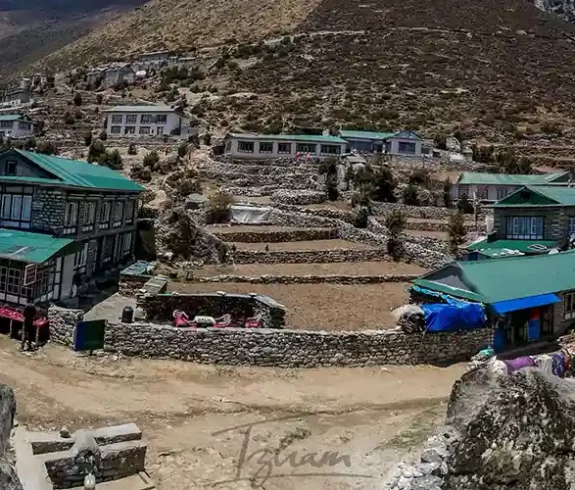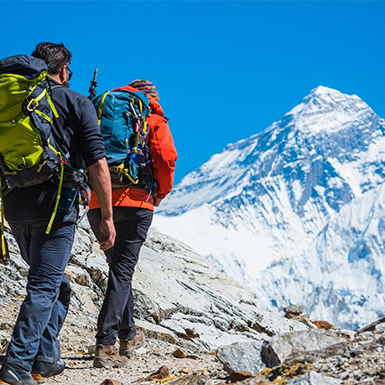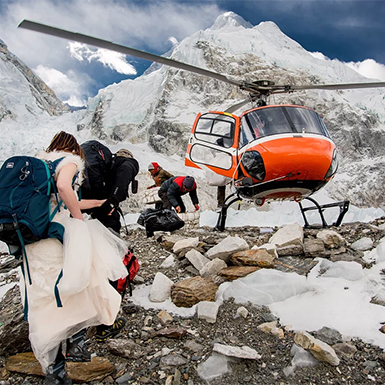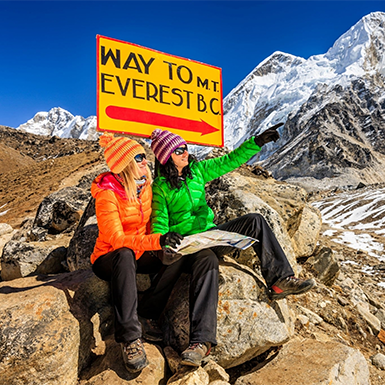Khumjung Nepal is a picturesque Sherpa village nestled in the Khumbu Region. Its rich cultural tapestry and breathtaking mountain vistas have earned it worldwide fame. This traditional village, located at approximately 3,790 meters, is a must-visit for those exploring the Everest region.
As part of the famous Everest trekking route, Khumjung offers more than stunning scenery. Its cultural and historical significance adds depth to any trek in the region. Below, we explore why Khumjung, Nepal, is an essential stop for trekkers and cultural enthusiasts.
A Stepping Stone to Everest
- Acclimatization Hub: Situated at 3,790 meters (12,434 feet), Khumjung is a crucial acclimatization stop for trekkers to Everest Base Camp. At the village’s moderate elevation, hikers can gradually adapt to the thinner air, reducing their chances of altitude sickness.
- Scenic Gateway: Khumjung is easily accessible from Namche Bazaar, a bustling Sherpa town and a central trekking hub. The distance between the two is a mere 3.5 kilometers (2.2 miles), making it a pleasant day hike or a comfortable addition to any Everest itinerary.

Cultural and Historical Tapestry
- Spiritual Center: Khumjung is home to the venerable Khumjung Monastery, a significant spiritual and cultural landmark for the Sherpa people. This ancient gompa houses priceless artifacts, sacred texts, and intricate murals, illuminating the region’s rich Buddhist heritage.
- Living Museum: The village itself is a living museum of Sherpa culture. Wander through the narrow stone-paved streets, observe the traditional architecture, and interact with the warm and welcoming locals. You’ll witness a way of life deeply connected to the mountains and their rhythms.
- Historical Significance: Khumjung has played a vital role in the history of Himalayan mountaineering. Many legendary Sherpa climbers hail from this region, including Tenzing Norgay, who was the first to summit Everest alongside Sir Edmund Hillary. Their tales of bravery and fortitude inspire visitors from around the globe.
Khumjung Altitude and Its Significance
Khumjung Nepal sits at an impressive altitude of approximately 3,790 meters (12,434 feet). This elevation places it among the higher settlements in the Everest region, making it an essential stop for acclimatization during treks to Everest Base Camp. The high altitude contributes to Khumjung’s unique climate and environment and allows visitors to experience life at the foothills of some of the world’s tallest mountains.
Location and Landmarks
Khumjung enjoys a prime location within the Khumbu region, nestled amidst iconic landmarks that define the Everest experience.
- Proximity to Namche Bazaar: Just a short 3.5-kilometer (2.2-mile) hike from the bustling Sherpa town of Namche Bazaar, Khumjung, is easily accessible for day trips or overnight stays.
- Gateway to Everest: The village lies along the famous Everest Base Camp trekking route, making it a convenient and scenic stopover for adventurers.
- Panoramic Views: Khumjung is renowned for its awe-inspiring vistas. Majestic peaks like Ama Dablam, Thamserku, and the sacred Khumbila dominate the skyline, creating a backdrop that will leave you breathless.
Scenic Splendor
The landscape surrounding Khumjung is a tapestry of natural beauty.
- Mountain Majesty: Snow-capped peaks pierce the sky, their grandeur a constant reminder of the power and serenity of the Himalayas.
- Sherpa Farmlands: Terraced fields meticulously carved into the slopes showcase the Sherpa people’s harmonious relationship with the land.
- Spiritual Significance: Prayer flags flutter in the wind, adding a touch of vibrant color and spiritual energy to the landscape.
- Tranquil Trails: Numerous hiking trails wind through the surrounding hills, offering opportunities for exploration and solitude.

Khumjung Monastery: A Cultural and Spiritual Hub
Khumjung Monastery, also known as the Edmund Hillary School Monastery, is one of Khumjung Nepal’s most significant cultural and spiritual landmarks. Located in the heart of this Sherpa village, the monastery serves as both a religious sanctuary and a community hub. Its rich history and serene atmosphere make it a must-visit for trekkers and spiritual seekers traveling through the Everest region.
Spiritual Significance
- Center of Buddhist Practice: The monastery is a focal point for Buddhist worship and learning. Monks reside and study here, preserving ancient traditions and passing down wisdom through generations.
- Community Gathering Place: Locals gather at the monastery for prayers, festivals, and important events, strengthening the bonds that tie the community together.
- Preserving Sherpa Heritage: The monastery actively safeguards the unique cultural heritage of the Sherpas, ensuring that their traditions and beliefs continue to thrive.
Edmund Hillary’s Legacy
The monastery’s association with Sir Edmund Hillary, the first person to summit Mount Everest, adds to its significance. Hillary, recognizing the importance of education in the region, helped establish a school within the monastery complex. This initiative has empowered countless Sherpa children, providing them opportunities for a brighter future.
The Enigmatic Yeti Scalp
One of the monastery’s most intriguing features is the famed “Yeti scalp.” This curious artifact, kept under lock and key, has fueled fascination and debate for decades. While its authenticity remains a subject of scientific inquiry, the Yeti scalp adds a touch of mystery and folklore to the monastery’s allure, drawing visitors from far and wide.
Visiting Khumjung Monastery
- Respectful Exploration: Remember to respect the monastery’s sacred nature when visiting. Dress modestly, remove footwear upon entry, and refrain from taking pictures.
- Donations: Consider making a small donation to support the monastery’s upkeep and educational initiatives.
- Cultural Immersion: Observe the monks’ daily routines, participate in prayer ceremonies (if permitted), and converse with locals to gain deeper insights into Sherpa culture and spirituality.

Essential Guide to Trekking from Namche Bazaar to Khumjung Nepal
Trek from Namche Bazaar to Khumjung, Nepal, to experience breathtaking views and explore the unique cultural heritage of the Khumbu region. Perched at approximately 3,790 meters, the traditional Sherpa village of Khumjung provides a peaceful contrast to the bustling trails leading to Everest Base Camp.
Route Details
- Distance and Duration: This trek can be comfortably completed in about 2-3 hours, making it an ideal half-day trek for those acclimatized to Namche Bazaar’s altitude of 3,440 meters.
- Elevation Gain: The trek sees you ascending around 350 meters. This gradual climb suits moderate-level trekkers well and offers excellent acclimatization opportunities.
Practical Trekking Tips
Best Time to Trek:
You can best enjoy this trek during the spring months of March to May and the autumn months of September to November. These months bring clear skies and moderate weather, ensuring optimal visibility and trail safety conditions.
Understanding the Difficulty:
This trek is classified as moderate and is manageable for those with basic fitness levels, yet it remains engaging due to the altitude challenges.
Acclimatization Tips:
Allocate a few days to acclimate in Namche Bazaar before you trek to Khumjung. This strategy reduces altitude sickness risks and improves your trekking performance.
What to Carry:
Pack essentials like water, snacks, sun protection, and layered clothing for changing temperatures. Remember your camera to capture the stunning vistas of Ama Dablam and other Himalayan peaks.
Trail Etiquette:
Follow marked trails, respect the local wildlife, and ensure you leave no trace. Engage respectfully with local communities and support their economies by buying local goods.
Health and Safety:
You and your fellow trekkers should be aware of any signs of altitude sickness. Always carry a basic first aid kit and know where to find the nearest medical facilities.
Cultural and Scenic Highlights
- Khumjung Monastery: Visit the iconic Khumjung Monastery, a cornerstone of local culture that also shelters the intriguing “Yeti scalp.”
- Scenic Beauty: The route offers unmatched views of the Himalayas, including the impressive peaks of Thamserku and Kongde Ri. The pristine and peaceful surroundings make this trek unforgettable.

Exploring the Local Culture and Lifestyle in Khumjung Nepal
The Sherpa people of Khumjung Nepal proudly uphold a vibrant, traditional way of life that encapsulates their rich cultural heritage. Their daily lives revolve around farming, raising livestock, and practicing their Buddhist faith. The community’s close connection to their land and environment shapes their routines and activities.
- Farming and Livestock: The Sherpa community in Khumjung, Nepal, relies heavily on subsistence agriculture to preserve its cultural heritage and provide for its households. It grows barley, potatoes, and vegetables to sustain its families. It also raises livestock, including yaks and dzos, which provide essential resources like milk, meat, and transportation.
- Community Life: Khumjung Nepal thrives on strong community bonds. Traditional values guide daily interactions, and family ties remain central to life in the village. Communal activities are vital to the Sherpa lifestyle, reinforcing their sense of togetherness.
Traditional Practices and Customs
Despite modern influences, the Sherpa people of Khumjung Nepal have preserved their customs and traditions. Their practices are deeply rooted in Tibetan Buddhism, which continues to play a central role in their lives.
- Religious Practices: In Khumjung, Nepal, religion is of profound importance in the lives of the Sherpas. The Khumjung monastery is a critical cultural and spiritual site for the community. The monastery hosts ceremonies and festivals throughout the year that unite the village. It functions as a place of worship and a gathering space for locals to celebrate their traditions.
- Festivals and Rituals: The Sherpa community celebrates festivals like Losar (Tibetan New Year) and Mani Rimdu with vibrant rituals. These events feature traditional dances, music, and communal feasts, illuminating Sherpa culture.
- Cultural Preservation: The Sherpa community in Khumjung, Nepal, has worked diligently to protect its cultural heritage despite the impact of modernization. They continue to wear traditional clothing, practice age-old crafts, and maintain their language and customs.
Adapting to Modern Influences
Although the Sherpas of Khumjung Nepal have integrated some aspects of modern life, they remain committed to balancing these changes with their traditional values.
- Modern Amenities: Access to modern conveniences, such as electricity and communication tools, has made daily life easier for the Sherpas in Khumjung, Nepal. However, they carefully ensure that these advancements maintain their traditional way of life.
- Education and Tourism: The rise of education and tourism has brought new opportunities and challenges to Khumjung Nepal. While these developments contribute to the local economy, the community remains dedicated to preserving its cultural identity and traditions.
Notable Landmarks and Attractions in Khumjung, Nepal
Khumjung, Nepal, is more than just a traditional Sherpa village; it is home to several notable landmarks and attractions that captivate visitors. Whether you’re interested in history, nature, or local culture, Khumjung offers various experiences.
Hillary School
One of the most significant attractions in Khumjung, Nepal, is the Hillary School, established by Sir Edmund Hillary in 1961. Sir Hillary’s legacy lives on through this school, which is crucial in educating the region’s Sherpa youth. For visitors, the school symbolizes the positive impact of collaboration between international figures and local communities. It’s an inspiring place that showcases how education can transform lives in remote areas.
Khumjung Monastery
Another must-visit attraction is the Khumjung monastery. This sacred site is a cultural and spiritual hub for the local Sherpa community. Visitors can explore the monastery, which is famous for housing a relic known as the “Yeti scalp.” The monastery offers a peaceful environment for reflection and provides insight into the religious practices that shape life in Khumjung, Nepal.
Rhododendron Forests
Surrounding Khumjung, Nepal, you’ll find vibrant rhododendron forests that come alive during the spring months. These lush forests offer a stunning display of color, with bright red, pink, and white rhododendron blooms blanketing the landscape. Trekking through these forests provides a refreshing escape into nature and a chance to experience the region’s natural beauty up close.
Local Tea Houses
Khumjung, Nepal, is also known for its cozy local tea houses, where trekkers can take a break and enjoy traditional Sherpa hospitality. These tea houses offer a warm, welcoming atmosphere and a taste of regional cuisine. They serve as ideal rest stops for trekking through the region, providing comfort and a glimpse into everyday Sherpa life.
Peaceful Environment
The serene environment of Khumjung, Nepal, makes it a unique stop for trekkers. Unlike the busier parts of the Everest trekking route, Khumjung offers a quieter, more relaxed experience. Majestic peaks like Ama Dablam and Thamserku surround the village, creating a tranquil backdrop for reflection and rest. The peaceful atmosphere allows visitors to fully appreciate the region’s natural beauty and cultural richness.
Accommodation and Amenities in Khumjung, Nepal
Khumjung, Nepal, offers a variety of accommodation options tailored to the needs of trekkers and travelers. Here’s a guide to help you choose the best place to stay and understand what amenities are available:
Teahouses and Lodges: Your Himalayan Home
Teahouses and lodges serve as the heart of hospitality in Khumjung. These family-run establishments create a friendly and inviting ambiance where you can relax, recharge, and share stories with fellow adventurers.
- Comfortable Rooms: Most teahouses and lodges provide simple yet cozy rooms, typically equipped with twin beds and shared bathrooms. Depending on the time of year and availability, you might also find private rooms.
- Gather & Dine: The communal dining area, often warmed by a traditional wood-burning stove, is the social hub of any teahouse. Here, you can enjoy delicious Sherpa meals, exchange tales with other trekkers, and experience the genuine warmth of local hospitality.
- Mountain Vistas: Many teahouses boast spectacular views of the surrounding mountains. Imagine starting your day with a mesmerizing view of snow-capped mountains while enjoying warm tea.
Amenities and Services for Your Convenience
While retaining its traditional charm, Khumjung offers essential amenities and services to cater to trekkers’ needs.
- Food & Drinks: Teahouses and lodges serve various meals, snacks, and beverages. You can fuel up with hearty breakfasts, enjoy satisfying lunches, and indulge in comforting dinners prepared with local ingredients and flavors.
- Stay Charged: Most places offer charging facilities for a small fee, ensuring your devices are always ready to capture your unforgettable moments.
- Connect with the World: Some teahouses and lodges offer Wi-Fi, although the connection might be slower than you’re used to in urban areas. Share your incredible trek with others and stay connected with loved ones.
- Basic Healthcare: Khumjung has a health post that can provide essential medical attention. Local providers may transfer you to Namche Bazaar or Lukla if you need more serious medical assistance.
Plan Your Stay
- Book Ahead: During the peak trekking seasons of spring and autumn, it’s wise to book your accommodation in advance, especially if you’re looking for a private room or a specific teahouse.
- Pack Smart: Remember, you’ll be carrying your backpack, so pack light and focus on the essentials.
- Respect Local Traditions: Be mindful of Sherpa culture and customs. Dress modestly, take off your shoes before entering sacred spaces, and always ask before taking photos of people.
Cultural Etiquette and Responsible Tourism in Khumjung, Nepal
When you visit Khumjung, Nepal, respecting local culture and practicing responsible tourism is crucial to preserving the village’s unique heritage and environment. Following these guidelines can positively impact the local community and help protect the region’s beauty.
Respecting Local Culture and Traditions
- Dress Modestly: Sherpas value modesty in their culture. To show respect, cover your shoulders and knees, especially when visiting sacred places like Khumjung Monastery. This simple act shows respect for local customs and religious practices.
- Be Mindful of Religious Practices: Show respect at Khumjung monastery by maintaining silence and observing local traditions. Walk clockwise around stupas and mani (prayer stone walls), demonstrating respect in Buddhist culture. Avoid pointing your feet at religious items and sitting with your back to sacred spaces.
- Ask Before Taking Photos: While the beautiful scenery in Khumjung, Nepal, may inspire many photos, always ask for permission before taking pictures of local people or religious ceremonies. This small gesture shows respect for their privacy and cultural sensitivities.
- Respect Local Norms: Public displays of affection might seem inappropriate in Sherpa culture, so it’s best to avoid them. Also, refrain from offering money or gifts to children, as this can encourage begging and dependency.
Practicing Responsible Tourism
- Conserve the Environment: A delicate mountain ecosystem surrounds Khumjung, Nepal. Help protect it by carrying your trash until you can properly dispose of it. Reduce plastic use by bringing and refilling a reusable water bottle at safe water stations.
- Support Local Businesses: Boost the local economy by purchasing goods and services from local businesses. Stay at locally-owned teahouses and lodges and buy handmade crafts or souvenirs from local artisans. Your support directly helps sustain the livelihoods of the Sherpa community in Khumjung.
- Minimize Your Impact: Stay on marked trails while trekking to prevent soil erosion and protect the natural environment. Preserve the natural environment by observing animals from a distance and minimizing habitat disturbances. Consider using eco-friendly products to reduce your environmental impact.
- Learn About the Culture: Before your trip, learn about Sherpa culture, traditions, and history. This knowledge will deepen your appreciation of the places you visit, like the Khumjung monastery, and allow for more meaningful connections with the local community.
Conclusion: Why Khumjung, Nepal, Should Be on Your Travel List
Khumjung, Nepal, is a must-visit destination for trekkers and anyone interested in experiencing authentic Sherpa culture. With its rich cultural heritage, stunning natural beauty, and significant historical sites like Khumjung monastery, this village offers a unique and unforgettable experience.
The Khumjung altitude provides an excellent acclimatization point for trekkers, while the Namche to Khumjung distance makes it an accessible and rewarding stop on the Everest trekking route. Visitors can enjoy the serene landscapes, surrounded by towering peaks, and engage with the warm and hospitable Sherpa community.







